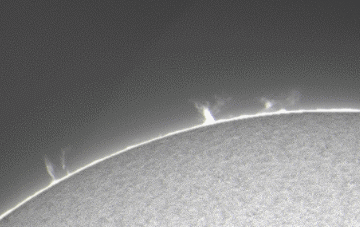Un video muy interesante Coldhearth

Disparado PLASMA BLOB: La actividad solar es baja, pero no es cero. Considere lo siguiente: El 5 de septiembre, Jean-Paul Godard de París, Francia, estaba viendo algunas prominencias de onda ligeramente por encima del borde del sol cuando, de repente, una gota de plasma se dispararon a la vista:
"Nunca he visto una expulsión tan rápido como esto antes", dice Godard. "



"I've never seen a fast ejection like this before," says Godard. "I recorded the action using a 3-inch refracting telescope and a Coronado SolarMax filter."
The blob does not appear to have escaped the sun. Indeed, it might not have been a blob at all, but rather a plasma wave traveling up a magnetic flux tube--and 'breaking' when it reached the top. Whether it was a rocketing blob or breaking wave, it shows that even the quiet sun is worth watching. Monitoring is encouraged.
more images: from Alan Friedman of Buffalo, New York; from Cai-Uso Wohler of Bispingen, Germany; from Francisco A. Rodriguez of Cabreja Mountain Observatory, Canary Islands; from Jimmy Eubanks of Boiling Springs, South Carolina; from Pavol Rapavy of Observatory Rimavska Sobota, Slovakia;
spaceweather.com/